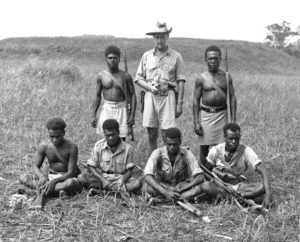British Solomon Islands Protectorate Defence Force facts for kids
The British Solomon Islands Protectorate Defence Force (BSIPDF) was a special military group in the British Solomon Islands during World War II. It was made up of local people from the islands. This force was formed in 1942 when the war with Japan began. It was later stopped in 1946. Today, the Solomon Islands does not have its own army. Instead, it uses the Royal Solomon Islands Police Force to keep peace and order.
The BSIPDF's Role in World War II
Even though the BSIPDF was a small group, it was very important in the Solomon Islands campaign during World War II. The leader of the BSIPDF was the Solomon Islands' Resident Commissioner. From 1942 to 1945, over 6,200 local Solomon Islanders joined the BSIPDF. They fought alongside Allied forces against the Empire of Japan.
These brave soldiers took part in big battles, like the famous Battle of Guadalcanal. Another 2,000 islanders joined a different group called the Solomon Islands Labour Corps. Also, special Allied helpers called Coastwatchers often worked with the BSIPDF during their missions.
Important Leaders of the BSIPDF
Many brave people were part of the BSIPDF. Here are some of the well-known members:
- Sir David Clive Crosbie Trench, who received the MC and the US Legion of Merit.
- Martin Clemens, who was awarded the CBE, the MC, and the AM.
- Sir Jacob Vouza, who earned the MBE, the GM, the US Silver Star, and the US Legion of Merit.
- Captain Donald Gilbert Kennedy, who received the DSO and the US Navy Cross.
How Local Knowledge Helped with Health
When US Marine doctors first arrived in Guadalcanal, they were not very familiar with the local health problems. They knew more about diseases in places like Central America. However, the experience of Dr. Edward Sayers from before the war was very helpful. He had studied malaria in the Western Province of the Solomon Islands. His knowledge helped the US forces lower the number of malaria cases during the Solomon Islands campaign.
At first, many sick soldiers were thought to have dengue fever. But two things made the doctors change their minds to malaria:
- Lieutenant Frank Stackpool, an Australian guide, had worked in the British Colonial Administration before the war. He knew a lot about how to treat malaria in the southern Solomons. He explained the British methods to the US Marines.
- Lieutenant Stackpool also showed that sick local workers got much better when treated for malaria.
After seeing these good results, the US Marine doctors quickly started using similar malaria treatments for their own sick soldiers. This was important because a very dangerous type of malaria, Plasmodium falciparum, was common in the Solomon Islands. This was different from the less dangerous type of malaria found in places like Panama, which the US doctors knew better.
Mr. Martin Clemens' book, "Alone on Guadalcanal: A Coastwatcher's Story," and Mr. D.C. Horton's book, "Fire Over the Islands," both mention Mr. F. Stackpool. He worked as a Government Dispenser (like a pharmacist) for the British Colonial Administration from 1929 to 1948 in different parts of the Solomon Islands.


